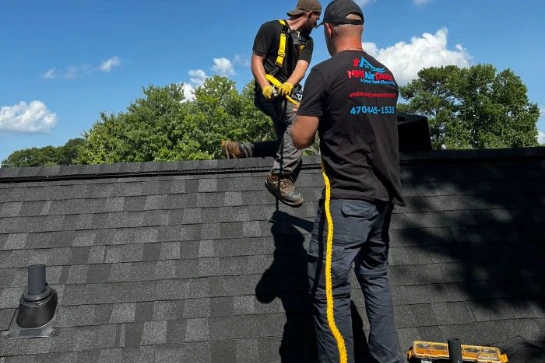A ceiling dryer vent helps remove hot, damp air from your dryer and pushes it outside. This keeps your home’s air dry and stops moisture from causing problems like mold or lint buildup, which can be risky. Here’s a simple guide to help you install a ceiling dryer vent for smooth airflow and safe operation.
Why Install a Ceiling Dryer Vent?
A ceiling dryer vent keeps damp air from staying indoors. It also helps your dryer run well, which makes it work better. By preventing heat and moisture from building up, it lowers the risk of lint-related fires. For extra safety and health benefits, consider using an Indoor Air Quality Testing Service. Following these steps, you’ll set up a vent that helps the dryer do its job better.
Keeping the air inside your home clean is important for a healthy place to live. Good ventilation not only protects your home but also makes it more comfortable. For this service, trust MMI for Indoor Air Quality Testing in Smyrna. This expert service makes sure you have a safe and pleasant atmosphere indoors.

Things You'll Need for Installing Ceiling Dryer Vent
Get these tools and supplies ready before you start:
– Measuring tape
– Power drill
– Hole saw (same size as your vent duct)
– Duct tubing
– Duct elbow (to make turns if needed)
– Exterior vent cover
– Metal duct tape
– Screws and screwdriver
– Safety gloves and goggles
These items will help make the installation go smoothly.
Step-by-Step Guide to Installing Your Ceiling Dryer Vent
Step 1: Choose the Best Path
Choose the shortest, most direct path from your dryer to an outside wall or roof. A straight path helps air flow easily, making your dryer more efficient. Try to avoid sharp turns in the duct, as they can slow down the air.
Step 2: Measure and Mark the Vent Location
Use a measuring tape to mark where you want the vent on the ceiling above the dryer. Mark the spot clearly so you’ll know where to cut. Double-check that there are no wires or pipes in this area.
Step 3: Drill a Small Guide Hole
Drill a small hole at your marked spot. This hole lets you check the placement before cutting a larger hole for the duct. It’s a quick way to make sure you’re in the right spot.
Step 4: Cut the Hole for the Vent Duct
Using a hole saw that matches the size of your duct, cut a hole in the ceiling. This hole will let the vent duct fit snugly, which helps with airflow.
Step 5: Feed the Duct Through the Ceiling
Feed the vent duct through the hole. If you need it to bend, attach an elbow fitting to guide it. A straight duct allows better airflow, so avoid too many turns.
Step 6: Attach the Duct to Your Dryer
Connect the duct to your dryer’s exhaust outlet. Use metal duct tape to secure it tightly, preventing any air leaks. Avoid using plastic tape as it can come loose.
Step 7: Guide the Duct to the Outside
Lead the duct through the ceiling to where it will exit on an outside wall or the roof. Keep it as straight as possible to prevent airflow blocks. You can secure the duct with brackets to prevent it from sagging.
Step 8: Install the Exterior Vent Cover
On the outside wall, cut a hole where the duct will exit. Attach the vent cover with screws to keep out rain, debris, and pests. This cover is important for protecting your duct.
Step 9: Connect the Duct to the Vent Cover
Feed the duct through the outside hole and attach it to the vent cover. Use metal duct tape to make sure there are no gaps where air could escape. Tight connections are important for strong airflow.
Step 10: Seal the Duct Connections
Check the duct for any gaps or loose spots. Seal these with metal duct tape. This keeps airflow strong and prevents moisture from escaping.
Read more about the Benefits of Air Duct Cleaning for Improved Indoor Air Quality
Maintenance Tips
To keep your ceiling dryer vent working well, follow these tips:
– Check the Outside Vent Regularly: Make sure the vent cover is clear of lint, debris, or anything that could block airflow.
Clean the Duct Yearly: To keep the dryer working efficiently, Clean out any lint from the duct once a year.
– Check Connections: Make sure that all connections are tight to prevent air leaks that can reduce airflow.
Common Mistakes to Avoid
Here are a few things to watch out for during installation:
- Using Plastic Ducts: Always use metal ducts, as plastic ones can warp or melt over time.
- Skipping Duct Tape on Connections: Loose connections let air escape, which can lower performance.
- Making Sharp Bends in the Duct: Sharp turns make air flow harder, leading to lint buildup.
- Leaving Out the Vent Cover: A cover is necessary to keep outside elements from entering your vent.
Testing Your Ceiling Dryer Vent
After you’ve finished the setup:
- Test the airflow.
- Turn on the dryer and check the outside vent cover to make sure the air is coming out strongly.
- Check for blockages, loose connections, or leaks if the airflow feels weak.
By following these steps and keeping up with regular checks, you can keep your dryer vent working smoothly and your home safer.

